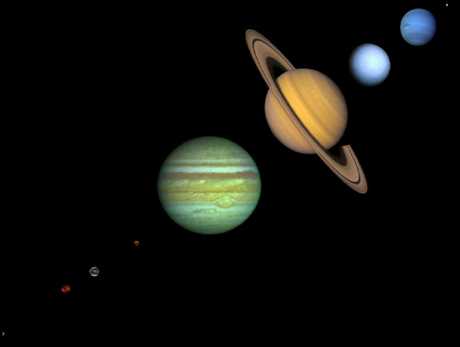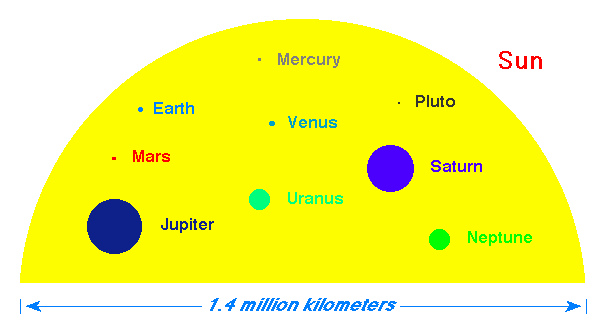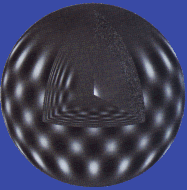
|
|
The Interior
of the Sun
|
In this section we consider only
the general properties of the Sun's interior.
Relative Volume of the Sun
The Sun is enormous compared with other objects in the Solar System, as
illustrated in the following image.
 |
The Sun
and planets drawn to
scale |
Thus, for example, the radius of the Sun is about 109 times that of the Earth,
which implies that the volume of the Sun would hold approximately 130,000,000
Earths (since the volume goes as the cube of the radius). However, the average
density of the Sun is much smaller than that of the Earth: about 1.4
g/cm3 compared with about 5.5 g/cm3 for the Earth. As we
shall see, this is because the composition of the Sun is dominated by the light
elements hydrogen and helium (similar to the Gas Giant planets), while that of
the terrestrial planets is dominated by heavier metals and their compounds.
Interior Zones of the Sun
It is useful to divide the interior of the Sun into three
interior regions. These are summarized in the following
table.
Interior Zones of the Sun
|
| Zone |
R/R(0) |
Temperature
( K) |
Density
(g/cm3) |
Energy
Transport
|
|
| Core |
0.0 - 0.25 |
~ 15,000,000 - 8,000,000 |
~ 160 - 10 |
Radiative
|
| Radiative
|
~ 0.25 - 0.85 |
~ 8,000,000 - 500,000 |
~ 10 - 0.01 |
Radiative
|
| Convective
|
~ 0.85 - 1.00 |
~ 500,000 - 10,000 |
< 0.01 |
Convective |
|
These zones may be characterized by their ranges of temperature and density,
and also by the mode of energy transport through them.
-
The core
is the hot, dense central region in which the nuclear reactions that
power the Sun take place. It comprises about 25% of the interior radius.
-
The
radiative zone
is comprised of the interior from about 25% to 85% of the solar
radius. It is called the radiative zone because here (and in the core) the
primary transport of energy is by photons (electromagnetic radiation).
-
The
convective zone
starts at about 85% of the solar radius and extends to just
below the surface. It is a region in which the change in temperature with
increasing radius is so
rapid that the Sun becomes unstable to convection (rapid up and down motion of
large packets of gas), much as the Earth's atmosphere becomes convectively
unstable on a hot Summer day and produces thunderstorms.
(The issue of energy production in the core of stars
from the interplay between gravity and fusion, and the
transport of that energy to the star's surface
will not be discussed in detail in this section.)
Helioseismology
One way to study the solar interior is through
helioseismology.
In helioseismology, one attempts to learn about the properties of the Sun by
studying the propagation of waves in its body (which, for example,
cause small oscillations of the surface that are observable)
in a manner similar to
geologists learning about the interior of the Earth by studying seismic waves.
The left image illustrates a computer generated model of acoustic waves in the
body of the Sun
(Source).
Presently, helioseismology is placing strong constraints on our
theories of the solar interior. This information is important, for
example, in the discussion of the
solar neutrino problem.



